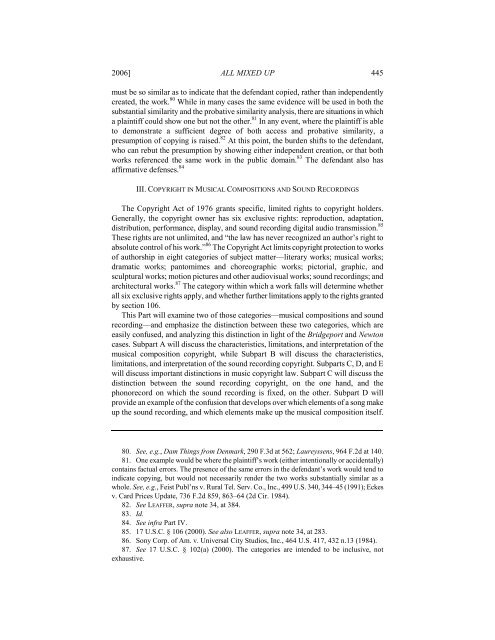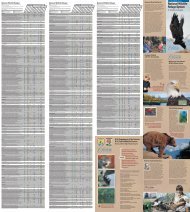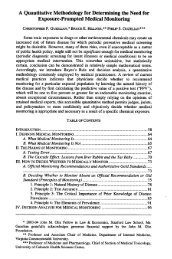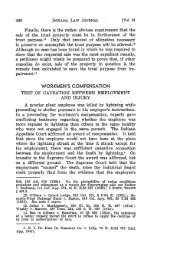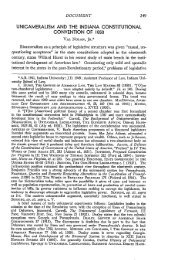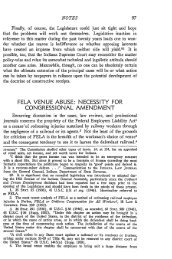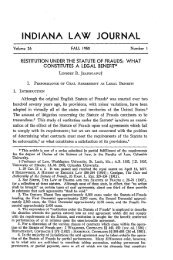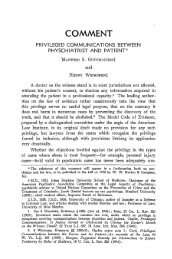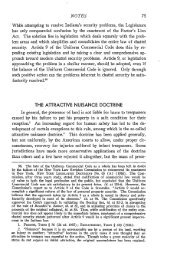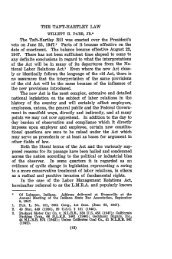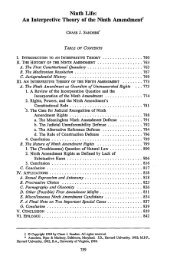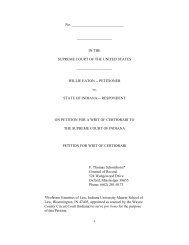Bridgeport Music v. Dimension Films - Indiana University School of ...
Bridgeport Music v. Dimension Films - Indiana University School of ...
Bridgeport Music v. Dimension Films - Indiana University School of ...
Create successful ePaper yourself
Turn your PDF publications into a flip-book with our unique Google optimized e-Paper software.
2006] ALL MIXED UP 445<br />
must be so similar as to indicate that the defendant copied, rather than independently<br />
created, the work. 80 While in many cases the same evidence will be used in both the<br />
substantial similarity and the probative similarity analysis, there are situations in which<br />
a plaintiff could show one but not the other. 81 In any event, where the plaintiff is able<br />
to demonstrate a sufficient degree <strong>of</strong> both access and probative similarity, a<br />
presumption <strong>of</strong> copying is raised. 82 At this point, the burden shifts to the defendant,<br />
who can rebut the presumption by showing either independent creation, or that both<br />
works referenced the same work in the public domain. 83 The defendant also has<br />
affirmative defenses. 84<br />
III. COPYRIGHT IN MUSICAL COMPOSITIONS AND SOUND RECORDINGS<br />
The Copyright Act <strong>of</strong> 1976 grants specific, limited rights to copyright holders.<br />
Generally, the copyright owner has six exclusive rights: reproduction, adaptation,<br />
distribution, performance, display, and sound recording digital audio transmission. 85<br />
These rights are not unlimited, and “the law has never recognized an author’s right to<br />
absolute control <strong>of</strong> his work.” 86 The Copyright Act limits copyright protection to works<br />
<strong>of</strong> authorship in eight categories <strong>of</strong> subject matter—literary works; musical works;<br />
dramatic works; pantomimes and choreographic works; pictorial, graphic, and<br />
sculptural works; motion pictures and other audiovisual works; sound recordings; and<br />
architectural works. 87 The category within which a work falls will determine whether<br />
all six exclusive rights apply, and whether further limitations apply to the rights granted<br />
by section 106.<br />
This Part will examine two <strong>of</strong> those categories—musical compositions and sound<br />
recording—and emphasize the distinction between these two categories, which are<br />
easily confused, and analyzing this distinction in light <strong>of</strong> the <strong>Bridgeport</strong> and Newton<br />
cases. Subpart A will discuss the characteristics, limitations, and interpretation <strong>of</strong> the<br />
musical composition copyright, while Subpart B will discuss the characteristics,<br />
limitations, and interpretation <strong>of</strong> the sound recording copyright. Subparts C, D, and E<br />
will discuss important distinctions in music copyright law. Subpart C will discuss the<br />
distinction between the sound recording copyright, on the one hand, and the<br />
phonorecord on which the sound recording is fixed, on the other. Subpart D will<br />
provide an example <strong>of</strong> the confusion that develops over which elements <strong>of</strong> a song make<br />
up the sound recording, and which elements make up the musical composition itself.<br />
80. See, e.g., Dam Things from Denmark, 290 F.3d at 562; Laureyssens, 964 F.2d at 140.<br />
81. One example would be where the plaintiff’s work (either intentionally or accidentally)<br />
contains factual errors. The presence <strong>of</strong> the same errors in the defendant’s work would tend to<br />
indicate copying, but would not necessarily render the two works substantially similar as a<br />
whole. See, e.g., Feist Publ’ns v. Rural Tel. Serv. Co., Inc., 499 U.S. 340, 344–45 (1991); Eckes<br />
v. Card Prices Update, 736 F.2d 859, 863–64 (2d Cir. 1984).<br />
82. See LEAFFER, supra note 34, at 384.<br />
83. Id.<br />
84. See infra Part IV.<br />
85. 17 U.S.C. § 106 (2000). See also LEAFFER, supra note 34, at 283.<br />
86. Sony Corp. <strong>of</strong> Am. v. Universal City Studios, Inc., 464 U.S. 417, 432 n.13 (1984).<br />
87. See 17 U.S.C. § 102(a) (2000). The categories are intended to be inclusive, not<br />
exhaustive.


